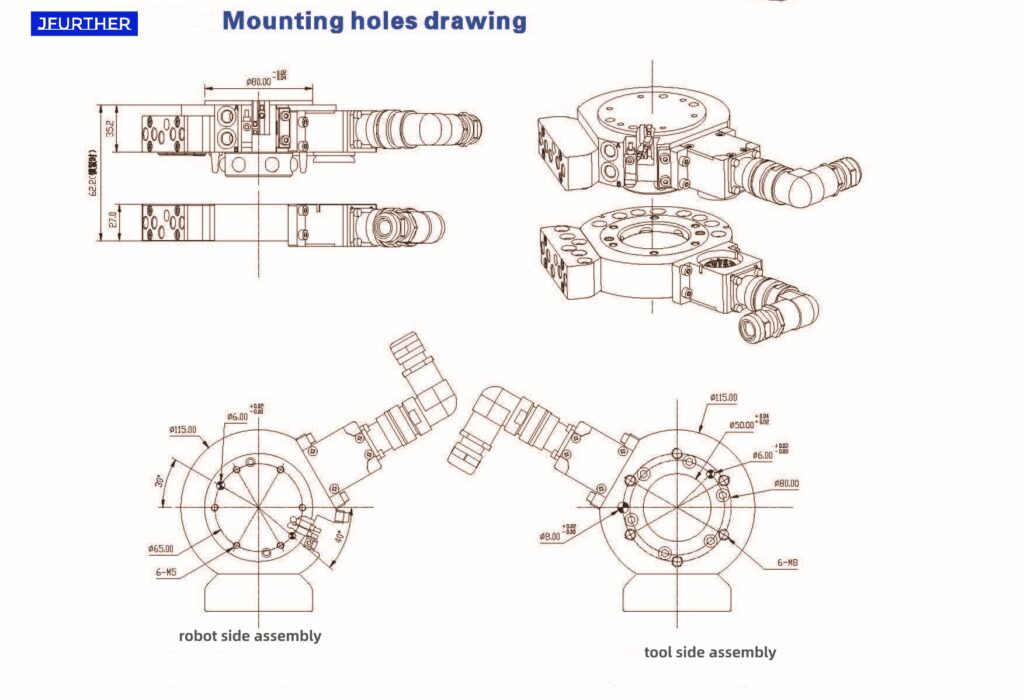In the fast-paced world of industrial automation, efficiency and versatility are key to maintaining competitive edge. One such innovation that has significantly enhanced the flexibility and productivity of robotic systems is the advanced robot quick change tooling, capable of handling payloads up to 50 kg. This article explores the features, benefits, and applications of this tooling system, emphasizing its role in improving operational efficiency and adaptability in various industrial settings.
Key Features of the robot end of arm tooling
1. High Payload Capacity: The tooling system is designed to handle payloads of up to 50 kg, making it suitable for a wide range of applications, from assembly to complex material handling. This capability allows industries to utilize the same robotic system for multiple tasks, varying from lightweight to relatively heavy components, enhancing the robot’s utility and flexibility.
2. Mechanical Locking Mechanism: One of the standout features of this eoat component is its robust mechanical locking mechanism. Even in the event of an air supply cutoff, the robot side and tool side remain securely connected, preventing any accidental separations. This feature ensures reliability and safety in operations, crucial in high-stakes industrial environments.
3. Steel Ball Lock System: The inclusion of a steel ball lock system further enhances the security and stability of the tool attachment. This system allows for a more durable and stable connection between the robot and its tools, which is essential for precision tasks and for maintaining the integrity of the operations under varying mechanical loads.
4. Compatibility with Ultrasonic Plastic Welding: In addition to its traditional uses, this quick change tooling can be integrated into specialized applications such as ultrasonic plastic welding. This versatility opens up new possibilities for industries that require quick adaptation of robots to different technologies without the need for extensive downtime or reconfiguration.
5. Compact and Lightweight Design: Despite its robust capabilities, the tooling system is designed to be small and light. This design not only makes the installation and changeover processes quicker and easier but also reduces the overall load on the robot. A lighter tooling system translates into faster movement speeds and reduced wear and tear on the robotic arm.
6. Convenient Signal Detection and Adjustment: The system is equipped with features for easy signal detection and adjustment, enhancing the control and monitoring capabilities during operations. This allows for precise calibration and troubleshooting, ensuring that the tooling system operates at optimal efficiency.
Applications and Benefits
The versatility and reliability of this quick change tooling system make it an invaluable asset across various sectors, including automotive, electronics, and manufacturing. Its ability to quickly switch between different tools and applications without compromising on safety or efficiency boosts productivity and reduces downtime. The system’s high payload capacity and compatibility with advanced processes like ultrasonic welding further broaden its applicability.
In automotive production, for example, the same robotic arm can switch between tools for welding, assembly, and material handling, thereby streamlining the production line and reducing the need for multiple specialized robots. In electronics manufacturing, the precision and stability provided by the steel ball lock system and mechanical locking mechanism ensure that delicate components are handled securely.
Conclusion
The robot quick change tooling with a 50 kg payload capacity represents a significant leap forward in robotic technology. Its advanced locking mechanisms, compatibility with specialized processes, and user-friendly features not only enhance the productivity and flexibility of robotic systems but also contribute to safer and more reliable industrial operations. As industries continue to evolve towards more integrated and versatile automation solutions, such tools will play a pivotal role in shaping the future of manufacturing and assembly.
